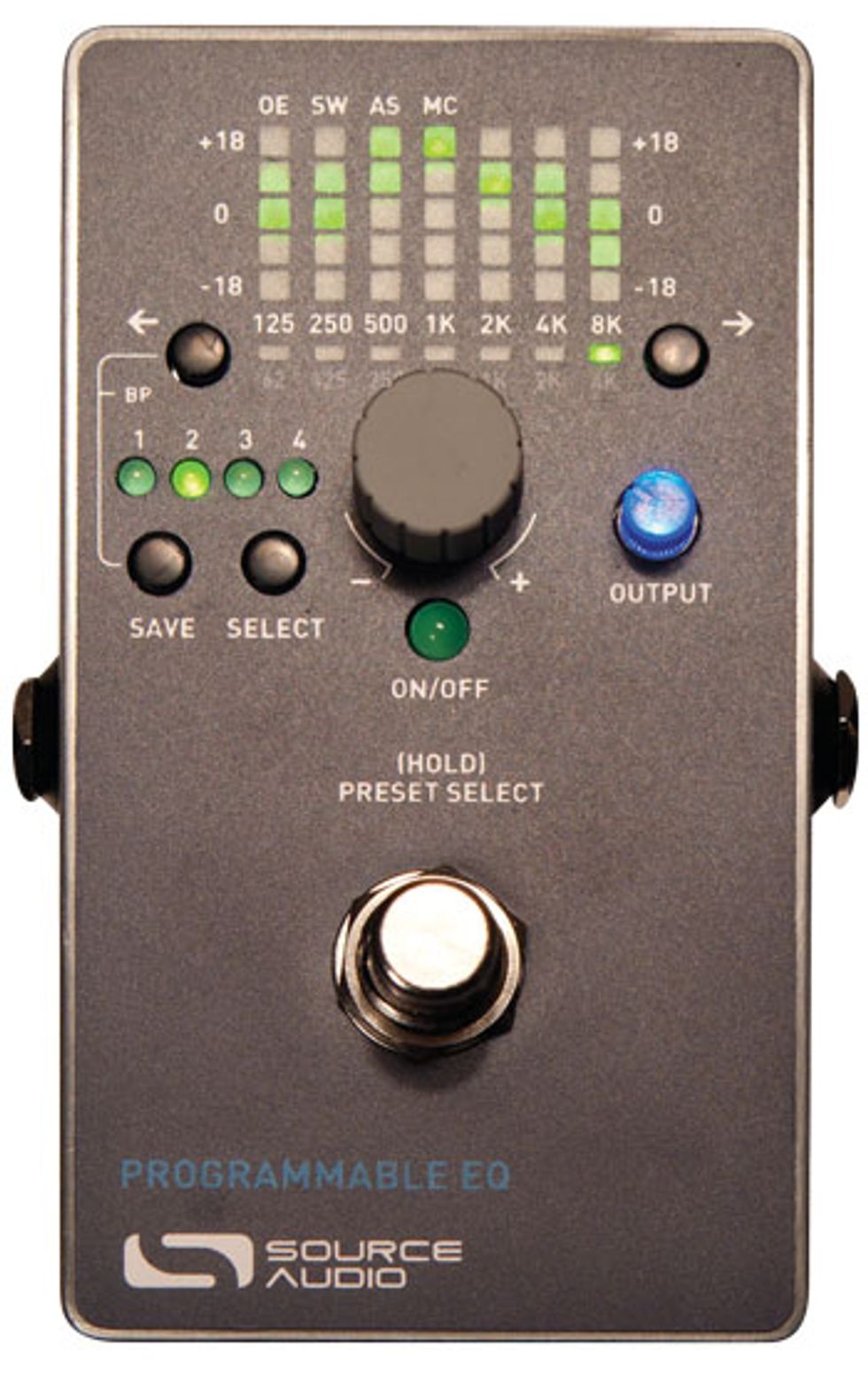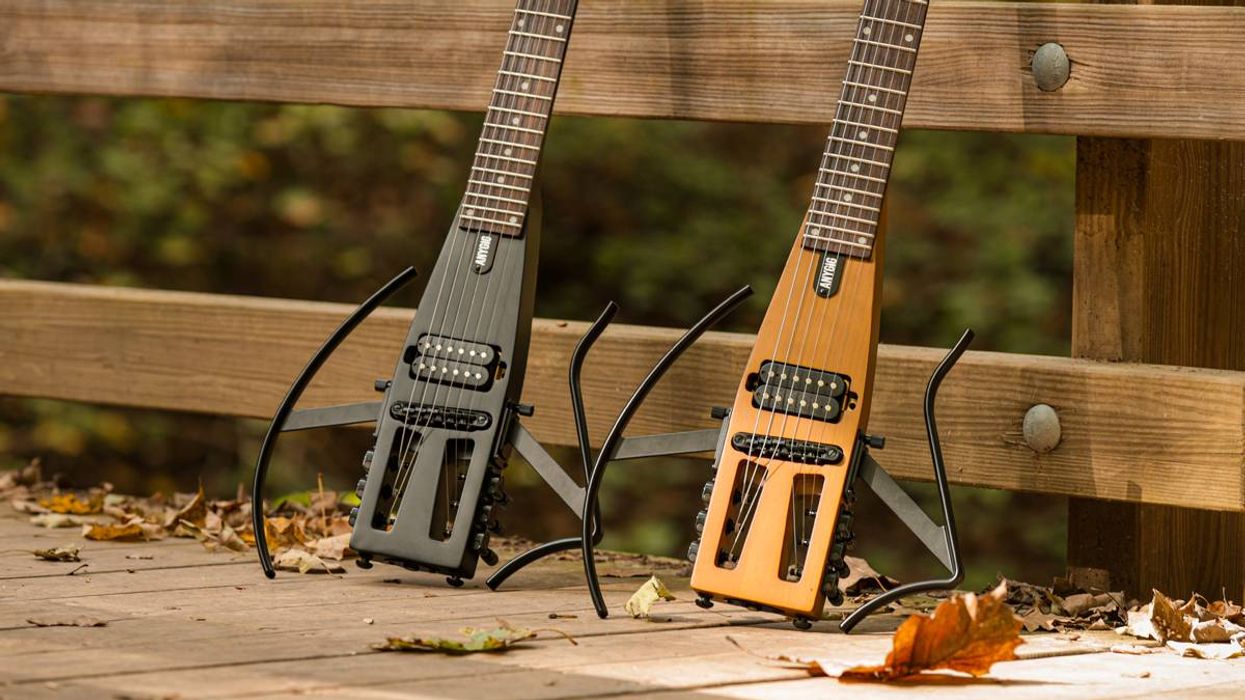
Rather than recasting the circuit designs of iconic effects, Massachusetts-based Source Audio operates with a think-outside- the-box ethos that’s resulted in products like the motion-controlled Hot Hand. So it’s fitting that the company’s recently released Programmable EQ is more than just another run-of-the-mill tool for fiddling with frequencies.
The true bypass Programmable EQ is a 56-bit, DSP-driven, MIDI-capable digital equalizer pedal that enables you to save up to four footswitch-selectable settings and an output control that works as a clean boost. It’s easy to use too. With the unique Auto- Scroll feature that helps create a wealth of truly unique sounds that you can use onstage and in the studio, you can tailor your rig to different guitars or drastically shift your tone on the fly.
Path to Equalization
If you’ve used any kind of EQ pedal before,
the Source Audio Programmable EQ’s basic
layout is pretty easy to decipher. There
are vertically oriented readouts for seven
frequency bands—125, 250, 500, 1K, 2K,
4K, and 8K—that register incremental level
changes from +/-18 dB boost or cut. Unlike
most EQ pedals, there are no physical sliders.
Instead, there’s a pair of band-select
buttons on the pedal to get to the desired
frequency, a big encoder knob to adjust the
individual frequencies, and lights to indicate
the levels. To quickly get all the bands
to zero, you simply press both band-select
buttons simultaneously. Just to the right of
the encoder knob, you’ll find the luminous
output knob, which has an LED indicator
with variable brightness. It gives you up to
12 dB of clean boost and glows brighter the
more you crank it up.
Hidden Agenda
The Programmable EQ also has a set of
functions that Source Audio calls Backpage
Parameters. One of the highlights of
Backpage mode is the Octave Extension
(denoted OE), a parameter well-suited for
bass that enables you to manipulate an extra
frequency of 62 Hz—one octave below
125 Hz—that can still be accessed after
exiting Backpage mode. Another available
parameter is Auto-Scroll (AE), which really
takes the Programmable EQ to places few
other stompbox EQs will go. This function
enables you to continually scroll through
all your saved settings, which can result
in unique effects that are able to sound
like a tremolo-meets-sequencer-meets-ring
modulator, depending on how extreme
your presets are. In some cases, the effect is
reminiscent of the Roger Linn AdrenaLinn
pedal (as heard on the intro to Green Day’s
“Boulevard of Broken Dreams”). The effect
might not be for everyone, but in the
hands of a crafty sonic tinkerer, it can be
the catalyst for some pretty unreal sounds.
The speed of the Auto-Scroll function can
be adjusted with another parameter called
Switching Speed (SW), and the faster the
setting, the more extreme the results.
Setting the Stage
I tested the Programmable EQ using a
Music Man Axis Sport, a Pro Co Rat distortion
pedal, and the clean channel of a
Mesa/Boogie Lone Star Special with all of
the tone controls set flat. Right off the bat,
I was struck by the Programmable EQ’s
transparency, which means you can finetune
the sound of your rig to a room or a
musical environment without sacrificing
any character. And the 56-bit processing
and 24-bit converters mean very quiet, hissfree
operation.
Ratings
Pros:
excellent and easy to use tone-sculpting options.
Great clean-boost sound.
Cons:
Band levels can be hard to visually distinguish from
certain angles. hidden menus can be confusing to work with.
Tones:
Ease of Use:
Build:
Value:
Street:
$149
Source Audio
sourceaudio.net
Setting the Programmable EQ to a familiar V-curve with scooped mids gave my Mesa the feel of a blackface Fender when played clean, and a girthy metal tone when I threw the Rat into the mix—both sounds were fantastic for rhythm. For a thicker lead sound with more sustain, I simply boosted the mids. Once I saved these two settings, I ended up leaving the Programmable EQ on and switching between the two presets: this simple application alone gives your rig amazing flexibility. And even if you’re not looking to aggressively tweak EQ parameters, the Programmable EQ’s output knob can be set and saved for various levels of clean boost.
The Verdict
With a conventional slider-based EQ
pedal, you’re most likely saddled with a
single setting. And typically, those levels
aren’t too easy to change on the fly. By
allowing you to save up to four presets, the
Programmable EQ becomes a much more
formidable tool—particularly on stage
where you want to maximize pedalboard
real estate and the sonic range of your
rig. And the range of EQ shifts that are
possible with the Programmable EQ can
radically transform your tone. But even if
you favor subtle EQ shifts between lean
rhythm parts or different passages, you
can subtly or dramatically emphasize them
with preset boost levels using the output
control. What’s more, the sounds from the
Auto-Scroll function can transform the
pedal from a very practical tone-shifting
tool to something much more bizarre,
depending on how radically you set things
up. At about 150 bucks, it’s a great way
to get a lot more out of even the simplest
guitar and amplifier rig—particularly if
you like it simple. No matter how you slice
it, this pedal puts a lot of sonic potential at
your feet for the price.










![Rig Rundown: AFI [2025]](https://www.premierguitar.com/media-library/youtube.jpg?id=62064741&width=1245&height=700&quality=70&coordinates=0%2C0%2C0%2C0)



